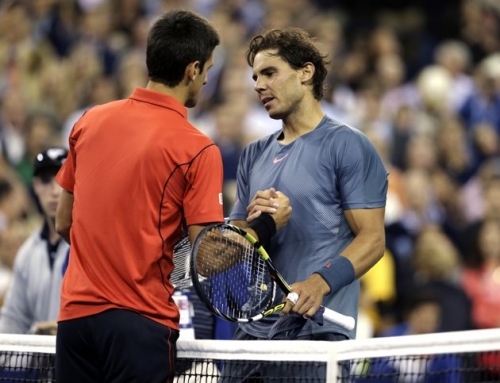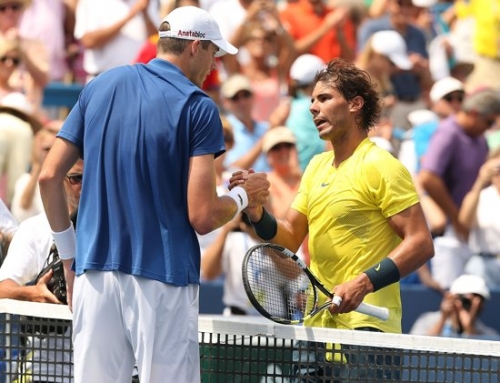 If you were to watch clay court tennis from the 1970s or the 1980s, you’d find a style of play that would seem a bit quaint by today’s standards. The best clay courters of the day were using heavy topspin because the clay would allow those shots to jump up and it allowed consistency. When racquets went from wood to graphite, topspin was the key to controlling the power that would otherwise be too difficult to keep in court time and again.
If you were to watch clay court tennis from the 1970s or the 1980s, you’d find a style of play that would seem a bit quaint by today’s standards. The best clay courters of the day were using heavy topspin because the clay would allow those shots to jump up and it allowed consistency. When racquets went from wood to graphite, topspin was the key to controlling the power that would otherwise be too difficult to keep in court time and again.
But that power wasn’t full exploited until the 1990s. Up to then, steady play from the baseline was they key. A player maneuvered their opponent around, and typically waited for the error. In those days, it was a grinding style of play that didn’t seem to allow for finesse. The closest clay court tennis ever got to finesse was when John McEnroe made the finals of the French in 1984, but he was a net rusher, a player of old school tennis brought to genius level. And even McEnroe couldn’t get past Lendl who was desperately seeking a first Slam after having come up second so many times.
By the 1990s, players like Agassi and Courier were starting to apply more power to the baseline game, and this power continued to increase throughout the 2000s and through to today. This power forced players to play back from the baseline, sometimes significantly back from the baseline. Compared to the play of the 1960s and 1970s, players were incredibly far back, and yet, even from that distance, they could hit winners.
By 2000, at the very least, it became apparent that all this backcourt play made players vulnerable to the drop shot. Clay makes the drop shot more effective, the surface seemingly able to stop a ball in its tracks provided the right amount of spin was applied.
The nature of the drop shot has changed some too. The main problem with the drop shot is that its effectiveness is tied to how short you can keep the ball, as well as how long it takes before that ball bounces a second time. In the past, players generally attempted the drop shot fairly close to the net, perhaps on balls near the service line, and they would get the ball to clear the net by a small amount. Roger Federer may have been among the first to hit a drop shot with a much higher arc, almost a half-hearted lob, but this high arc meant the ball would not bounce forward, but more up, and if the spin was right, the ball wouldn’t even bounce up much.
Two players that used the drop shot on all surfaces frequently are Novak Djokovic and Andy Murray. Federer uses it a lot on clay, and has used it more than ever as he’s gotten older. While he used it 5 years ago, he was more sparing with its use. For a while, he disdained the drop shot, figuring it was for players that didn’t have good groundstrokes, but as players hit harder and harder, Federer has re-thought his position on this most delicate of shots, and it’s no surprise that the man that can hit any ball can hit this shot well too.
The drop shot is not nearly as common as the drop volley in tennis. These days, you hardly ever see a standard volley hit deep. Gone are the days when players knifed the volley deep into a corner. With players running as fast as they do now, and with racquet technology being what it is, you hit a great volley deep, and the odds are you are diving hopelessly to get a passing shot dipped so quickly you can barely see it. The drop volley means the other player doesn’t get to hit a passing shot. In the past, that didn’t seem to be an issue. You allowed a player a pass attempt because you had the advantage at net.
Drop shots used to be under the purview of finesse players who used dinks and drops to deal with more powerful players, but now, it serves a power player precisely because it is a change of pace. No player relies on the drop shot as much as Ernests Gulbis who might put in a dozen drop shots a match. With a powerful serve and powerful groundstrokes, Gulbis pins his opponents deep behind the baseline, and makes them vulnerable to his drop shots.
The drop can be done cleverly too. Roger Federer will slice a short ball to an opponent’s backhand. Given the fear most players have of coming to net, they hit the ball and retreat back to the baseline. Roger will then hit the drop shot as the player is moving back, unable to switch directions quickly enough to get the drop. Should a player be unwise enough to stay put (which never happens at the pro level), Roger will then hit a power shot. Indeed, he sometimes does this because they are backing up, hoping to elicit and even weaker response that he can take advantage of.
Roger’s been known to hit drop shots as a second serve return, though he doesn’t do it that often. It works well for players that don’t move forward quickly.
The finesse game hasn’t exactly extended to other parts of the game. For example, it was somewhat common for players in the 1940s to hit a “chop”, which was a hard forehand slice. The closest analog in the modern game is the so-called “squash shot” which is only hit when a player is chasing a ball deep to the forehand and lacks the time to hit their normal shot. This slice shot gives them time to recover. You never see this shot hit when a player has time.
Although you see this rarely, a player can start to anticipate drop shots and get ready to run forward at the first sign of a dropper. Andy Roddick once fooled Novak Djokovic into thinking he was going to hit a drop shot, but instead, Roddick sliced the ball deep to the baseline. Although Roddick rarely gets to use the full repetoire of his game, he can hit drop shots and slices. It’s just that he prefers not to, as they may not be quite world class. Against a much lesser player, say a typical college player, he can choose to handicap his game by slicing on both sides, an exercise he has done in less serious situations.
Oddly enough, the drop shot is not that common in the women’s game. Indeed, the women don’t even slice all that much. What used to be the backhand of choice, namely, the slice backhand, has mostly disappeared. You never see the Williams sisters slice for a change of pace. They slice if they are in trouble.
With the increase in the use of the drop shot, there’s a bunch of standard replies to the drop. Most drops are hit to one sideline or the other, presumably because it constricts the way the opponent can respond. A drop shot hit in the middle opens up angles in two directions.
The most common response to the drop shot is the angled drop shot, aimed at the other sideline. This is another very delicate shot. The advantage of this shot, if well hit, is that you pass a person even standing close at net.
More rare, you can respond to the drop shot by getting it just over the net at the place the drop shot landed. This would only make sense if the opponent has elected not to follow his drop shot to the net.
Another response is to push the shot up the line. This is a more challenging shot because the net is so close and generally only makes sense if the drop is a little too deep.
Of course, if it goes deep enough, players can simply whip a crosscourt shot into the court, typically for a winner. David Ferrer and Rafael Nadal are great at doing this, even off balls that are barely get off the ground. However, the drop shot needs to be deep enough (usually about halfway between the net and service line) for this to work.
And if there’s a response to the drop shot, then surely, there’s a response to a response to the drop shot. Perhaps the most clever of those responses is the lob volley. In one of the more famous points in tennis history, Novak Djokovic hits a drop shot in the US Open semifinals. Roger rushes to net and barely gets the ball over and aims it down the line. Djokovic responds to this by hitting a lob volley over Federer who rushes back to the baseline to hit a tweener that goes crosscourt for the winner.
In another classic, Fabrice Santoro is doing the same thing to David Nalbandian, drop shotting him, then lob volleying him, then drop volleying him, then lob volleying him.
What’s fascinating about the drop shot in today’s game is that it provides an intriguing solution to a tough problem. How do you deal with power hitters? If the power hitters stand far back enough, you can deal with it using finesse. Drop shots used to be considered such a specialty shot that few players could hit it consistently well. The modern player now learns to hit this shot and respond to this shot, and it’s made modern men’s tennis that much more interesting to watch.




![[US Open Men’s Final] Can Djokovic beat Nadal in the finals?](https://www.essentialtennis.com/wp-content/uploads/2013/09/20130909djokovic-500x383.jpg)


![[French Open] The tactics of the Djokovic-Nadal semifinals](https://www.essentialtennis.com/wp-content/uploads/2013/06/20130607nole-500x383.jpg)